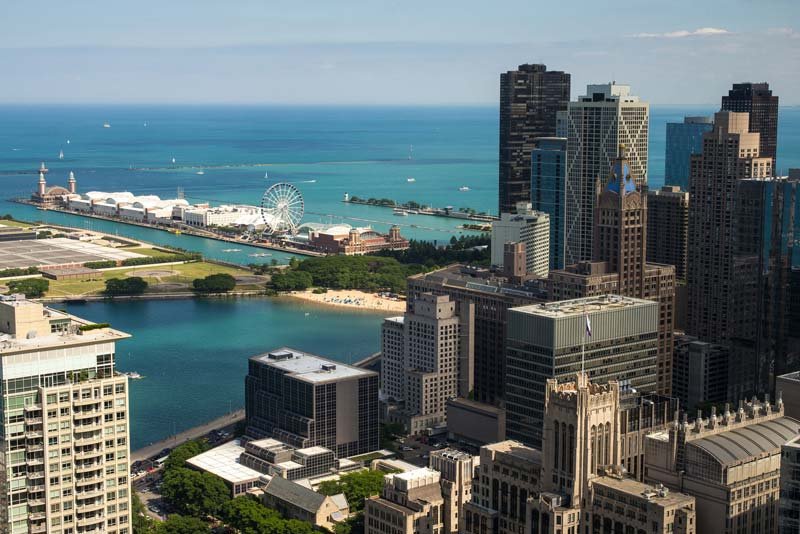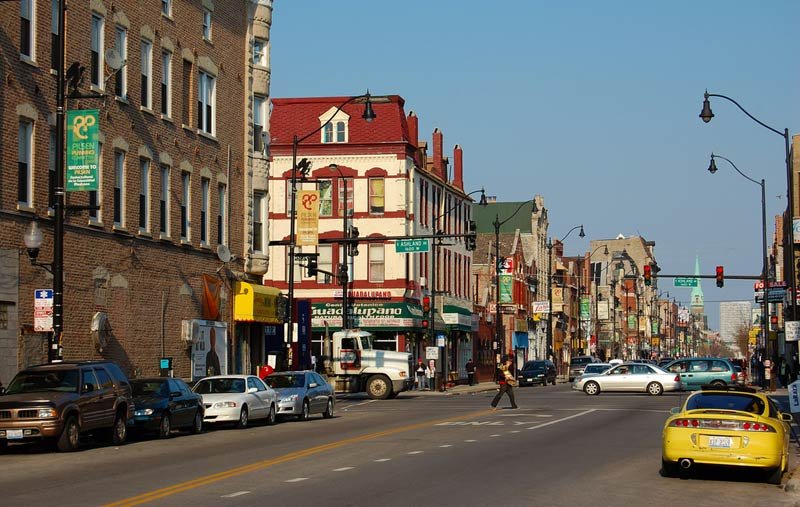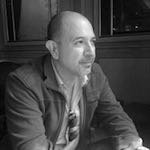Chicago is in my blood, even though today I consider myself a Californian. My parents immigrated to the Windy City in the late 1950s; my younger brother, my three older sisters and I were all born on the Westside.

Chicago has always been a tough, blue-collar town, made up of different ethnic neighborhoods that can be downright hostile to outsiders. But when my parents moved there, it was also a city where housing was very affordable, where working class wages were strong, and a place where you could get a good education at a fair price. Many Latino parents, like mine, were able to provide their families a solid, middle class existence. It wasn’t easy by any means; my father was a factory foreman who worked 6 days a week and my mother cleaned offices in Downtown Chicago at night. There were many sacrifices but there was obvious fruit being born from their hard labor. Chicago had an infrastructure in place through which immigrants and working class folks could work hard and better themselves within one generation. There was this other Mexican family we grew up with whose father worked in the steel mills for 30 years. He and his wife had seven children and in one generation produced a doctor, an RN, two teachers, and a lawyer, all of whom had received their education thanks to their father’s hard work all of those years in that steel mill.
We were raised in a close-knit Latino neighborhood called Little Village, or, as we referred to it, 26th Street. 26th street was the main thoroughfare; it was a busy street filled with all types of shops, supermarkets, restaurants, and bars. The side streets were made up of brown brick homes that were almost on top of each other. The only things separating them were narrow walkways. It was the 1970s and most of us were first generation Americans; our parents came from Mexico, Puerto-Rico, Cuba, El Salvador, Colombia, Guatemala, and Honduras. Many of the families owned their own homes and businesses. It was a unique experience: we shared a common heritage, yes, but also a dream for a better life. It was a cocoon, where we felt connected to one another. Most of us grew up speaking Spanish at home, visited the old country every summer, and enjoyed similar foods and traditions. We were shielded from the rest of the city.
But Little Village could also be a very violent place; there were gangs there who strictly enforced their territorial boundaries. We lived within one gang’s “hood” but our school and the park we played at were part of another gang’s territory. Navigating through this dangerous maze could be harrowing at times.
One cold winter evening, my brother and I were walking home from the Boy’s Club. It was dark and eerily quiet. We could only hear the wind and our footsteps against the snow-covered sidewalk. Almost out of nowhere, a gang of teenagers appeared. We didn’t recognize any of them. The group began running toward us but we knew enough not to run. We kept calm; we weren’t part of any gang so we had nothing to hide. The gangbangers soon surrounded my little brother and me. They were older kids so they towered over us. They asked us who we were and what we were doing in their hood. Now we were scared, shaking and shivering. Suddenly an older boy came out from the back, and was right in my face; he looked angry and menacing. Then, out of the blue, he said, “Hey, aren’t you la Senora Diaz’s kids?” We nervously nodded yes. A smile spread across his threatening face, he turned to his crew and said “they’re okay, leave them alone.” It turned out that the gang leader’s mother cleaned offices with my mother, and he recognized us. He turned to us one last time, and in a low voice asked us not to tell our mother about the incident. We never did.

Another time, I and some friends were eating at this very popular tacos and tortas restaurant on 26th Street. Suddenly we saw a gang member show up at the door of the establishment, with a shotgun in his hands. The owner of the restaurant, a middle-aged Mexican man, immediately grabbed a crowbar from behind the counter, ran out and confronted the gunman. The owner yelled out expletives at the gangbanger warning him to leave before he shoved the crowbar down his throat. The young thug could see that the old man meant business and left the premises without firing a shot. It turned out that there was a rival gangster eating at the restaurant that night, who was not supposed to be in that hood, but I guess he felt the food was that good. This courageous, tough-guy business owner, who was protecting his own turf, thwarted what could have been a very ugly scene.
For the most part, the gangbangers left the “good kids” alone. If you weren’t associated with a gang, they didn’t mess with you. I strongly believe that most of these gang members were also good kids at heart, they simply didn’t have the stability or support that they needed at home. Many of them actually had this unspoken respect for the hard working families living among them; whom they could see were just trying to better themselves. In their own way, they were rooting for us to make it.
Chicago is almost evenly made up of White Ethnics (Irish, Italians, Greeks, Polish, etc.), Latinos, and African-Americans; Asians make up a smaller percentage of the population. Even though it is diverse, it is a very segregated town and some of these communities don’t take too well to outsiders moving in.
The Irish arrived in the 1840s, while the other White Ethnics came at the end of the 19th century. African-Americans have always been part of the city but their numbers really increased during the Great Migration from the South between 1910-1940. Unfortunately, they were almost immediately segregated/relegated to the South Eastside of the city. This remains true for working-class African-Americans today and the area is still greatly underserved and ignored. Latinos, particularly Mexicans, arrived in large numbers in the 1920s and continue migrating there to this day. Chicago always had plenty of work to go around—the meat packing industry, the steel mills, factories, etc. that attracted the labor classes.
For the longest time, Latinos were somewhat considered as just another immigrant group in the Chicago experience, although much lower on the rung. Unlike African-Americans, once Latinos gained the means, they were able to move into traditionally White areas, as long as there weren’t too many of them and as long as they kept a low profile.
The Irish dominated the city’s political machine starting in the 1950s with the election of Richard J. Daley, who ruled the city with an iron fist. The city doled out services and monies to the neighborhoods that were dominated by White Ethnics. Everyone else was just an afterthought. In order to keep a stronghold on their power, Ethnic Whites felt the need to keep other groups down. This tribal mentality permeated all aspects of Chicago life from politics, to communities, to the labor environment.
After I graduated elementary school in the early 1980s we left Little Village, for a “better area.” Now, my brother and I found ourselves navigating a whole different set of circumstances. Instead of making sure we weren’t caught up in a gang crossfire we had to find our way around the racial/ethnic hotbeds that make up the city. We moved into a traditionally Irish-American enclave where, to put it politely, no one ever rolled out the welcome carpet for us. In fact, when we first moved in, some of the neighborhood teen-aged thugs would call us names and tell us to go back to where we came from, while the other neighbors simply ignored us for many years.
We attended an Irish Catholic High School on the far South Westside. The Brothers (Catholic Brothers are not priests, they are more like male nuns) who ran the school and taught there were looking out for their people. If you weren’t part of their tribe, you were on your own; members of the club received all of their attention and care. The Brothers knew the White students’ names, and their families intimately, while the minority students were virtually ignored. There was this Irish-American kid in my junior year geometry class who was always goofing off. He never turned in his homework on time and failed many exams throughout the semester. I worked hard; handed in my assignments on time, studied several hours a week, passed all of the exams, and got a B. I was shocked to find out that the mediocre White student also received a B, even though it was obvious that he didn’t deserve it. I later found out that his parents and the Brother who taught geometry played cards together every Friday night. Even though we all paid the same tuition it was obvious that some students got much more bang for their buck.
As a young adult in the early 1990s, I also experienced first hand how White ethnics looked out for their own. I worked my way through college with a job at UPS. I remember being assigned to a new unit, and one of my employees was a young Polish-American guy who was one of the top performers. When I first came onboard, he thought I was Italian; they used to call me Alex back then. When I told him that I was Latino, his attitude completely changed. He no longer worked hard and his now low performance started bringing down the team’s productivity. It wasn’t until my boss, who was of Polish descent as well, had a talk with him that the young man straightened out. It was also common at UPS back then to see non-college educated Whites get management positions over college-educated Blacks and Latinos. The people in positions of authority were part of a particular ethnic group so they helped their own first before anyone else.
I left the Windy City for many reasons; yes the winters were brutal, but the main reason I moved away was the us-against-them way of looking at the world. Sooner or later, this very ugly clannish mindset would kick into full gear. The ethnic Whites took care of their own at the expense of Latinos, African-Americans and other minorities. It’s part of Chicago’s notorious “patronage system.”
After a while “the beefs” (Chi-town slang for run-ins) got too much for me. I was tired of always fighting for my place in my own hometown. The negative racial comments that I heard on a regular basis stopped once I moved away from Chicago; first to Miami for graduate school then to LA. It was liberating. In Chicago I would regularly hear Whites put down African-Americans and Latinos. But they would always make the disclaimer of “You’re not like the rest of them. You’re different.” As if this made what they were saying acceptable. The discussion always seemed to turn to race for them.
It was as if Chicago Whites were obsessed with pointing out how everyone else was dysfunctional and not worthy of the opportunities offered in this country. It was sad and disturbing.

LA is much more inclusive, less judgmental, and more progressive. That’s why I relocated here many years ago. In Los Angeles, for the most part, you see groups of friends socializing around the city made up of people from different backgrounds—Black, White, Latino, Asian, Immigrant, Straight, Gay, etc. To this day, when I visit my hometown I’m amazed at how segregated the city remains. I still see people living and socializing only with those from their particular tribes. I am shocked to see the lack of diversity in their inner circles and neighborhoods.
Politically, the last two mayors of Los Angeles have had Mexican lineage; the political landscape here seems much more accessible than in Chicago. At the same time, Los Angeles is not, and has never really been, a place where working-class immigrants could thrive; economic segregation runs deep in the City of Angels. The income disparity is at its worst here. I see everyday how hard it is for working class, and even middle-class people to keep up here. You can buy a nice single family home in Chicago for well under $300,000. This is impossible in the City of Angels. When I travel around the country I am amazed at how expensive Los Angeles is compared to most other areas; lunch will cost you half most everywhere else what it costs here. One definitely has to think twice before coming here to start from the bottom.
But there are also many reasons people flock to LA, one of them being that people don’t feel confined or unwelcome in most parts of the city. Freedom to move about freely in your city can be exhilarating. That’s the lure of California: there is something here for everyone.
White ethnics, specifically the Irish, made Chicago into a place where working-class people could live decently and progress. The cost of living was affordable, blue-collar jobs paid fair wages, and there were unions that protected workers against managerial abuses. It was their way of building a society free of the oppressive and elitist Anglo-Saxon customs of the old world. Unfortunately, this new arrangement wasn’t really designed for non-whites. For minorities, there were additional obstacles placed in their way. Nonetheless, my Mexican family persevered and utilized this system to make sure we too received our shot at the American Dream.
There was a code in working-class Chicago; if someone had a problem with you they would definitely let you know, and you dealt with it right then and there. If somebody pushed you, you pushed them right back. This is what I refer to as “Growing up Chicago.” Even though the environment could be antagonistic, at least you knew where you stood: the gangs on 26th Street, our unfriendly White ethnic neighbors, and the in-your-face racist students and teachers at our Catholic High School. Chi-Town was definitely a tough city to grow up in but it was also the perfect place for my immigrant parents to have landed.

Share this post with your friends.

